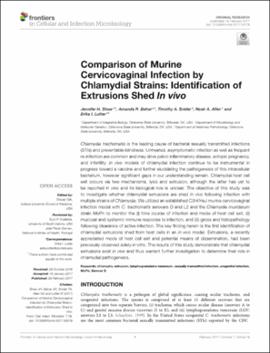| dc.contributor.author | Shaw, Jennifer H. | |
| dc.contributor.author | Behar, Amanda R. | |
| dc.contributor.author | Snider, Timothy A. | |
| dc.contributor.author | Allen, Noah A. | |
| dc.contributor.author | Lutter, Erika Ildiko | |
| dc.date.accessioned | 2019-08-28T16:00:51Z | |
| dc.date.available | 2019-08-28T16:00:51Z | |
| dc.date.issued | 2017-02-03 | |
| dc.identifier | oksd_shaw_comparisonofmur_2017 | |
| dc.identifier.citation | Shaw, J. H., Behar, A. R., Snider, T. A., Allen, N. A., & Lutter, E. I. (2017). Comparison of murine cervicovaginal infection by chlamydial strains: Identification of extrusions shed in vivo. Frontiers in Cellular and Infection Microbiology, 7. https://doi.org/10.3389/fcimb.2017.00018 | |
| dc.identifier.uri | https://hdl.handle.net/11244/321379 | |
| dc.description.abstract | Chlamydia trachomatis is the leading cause of bacterial sexually transmitted infections (STIs) and preventable blindness. Untreated, asymptomatic infection as well as frequent re-infection are common and may drive pelvic inflammatory disease, ectopic pregnancy, and infertility. In vivo models of chlamydial infection continue to be instrumental in progress toward a vaccine and further elucidating the pathogenesis of this intracellular bacterium, however significant gaps in our understanding remain. Chlamydial host cell exit occurs via two mechanisms, lysis and extrusion, although the latter has yet to be reported in vivo and its biological role is unclear. The objective of this study was to investigate whether chlamydial extrusions are shed in vivo following infection with multiple strains of Chlamydia. We utilized an established C3H/HeJ murine cervicovaginal infection model with C. trachomatis serovars D and L2 and the Chlamydia muridarum strain MoPn to monitor the (i) time course of infection and mode of host cell exit, (ii) mucosal and systemic immune response to infection, and (iii) gross and histopathology following clearance of active infection. The key finding herein is the first identification of chlamydial extrusions shed from host cells in an in vivo model. Extrusions, a recently appreciated mode of host cell exit and potential means of dissemination, had been previously observed solely in vitro. The results of this study demonstrate that chlamydial extrusions exist in vivo and thus warrant further investigation to determine their role in chlamydial pathogenesis. | |
| dc.format | application/pdf | |
| dc.language | en_US | |
| dc.publisher | Frontiers Media | |
| dc.rights | This material has been previously published. In the Oklahoma State University Library's institutional repository this version is made available through the open access principles and the terms of agreement/consent between the author(s) and the publisher. The permission policy on the use, reproduction or distribution of the material falls under fair use for educational, scholarship, and research purposes. Contact Digital Resources and Discovery Services at lib-dls@okstate.edu or 405-744-9161 for further information. | |
| dc.title | Comparison of murine cervicovaginal infection by chlamydial strains: Identification of extrusions shed in vivo | |
| osu.filename | oksd_shaw_comparisonofmur_2017.pdf | |
| dc.description.peerreview | Peer reviewed | |
| dc.identifier.doi | 10.3389/fcimb.2017.00018 | |
| dc.description.department | Integrative Biology | |
| dc.description.department | Microbiology and Molecular Genetics | |
| dc.description.department | Veterinary Pathobiology | |
| dc.type.genre | Article | |
| dc.type.material | Text | |
| dc.subject.keywords | mopn | |
| dc.subject.keywords | serovar d | |
| dc.subject.keywords | chlamydia | |
| dc.subject.keywords | extrusion | |
| dc.subject.keywords | lymphogranuloma venereum | |
| dc.subject.keywords | sexually transmitted infection | |
| dc.subject.keywords | urogenital infection | |
